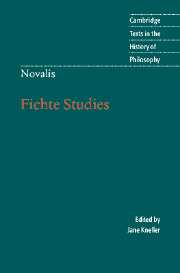Book contents
- Frontmatter
- Contents
- Preface
- Introduction
- Chronology
- Further reading
- Note on the text
- Fichte Studies
- Group I 1–210 (fall to early winter, 1795)
- Group II 211–287 (winter, 1795 to February, 1796)
- Group III 288–372 (February–March, 1796)
- Group IV 373–552 (March to early summer, 1796)
- Group V 553–568 (summer, 1796)
- Group VI 569–667 (summer to fall, 1796)
- Index
- Cambridge texts in the history of philosophy
Group II - 211–287 (winter, 1795 to February, 1796)
Published online by Cambridge University Press: 05 June 2012
- Frontmatter
- Contents
- Preface
- Introduction
- Chronology
- Further reading
- Note on the text
- Fichte Studies
- Group I 1–210 (fall to early winter, 1795)
- Group II 211–287 (winter, 1795 to February, 1796)
- Group III 288–372 (February–March, 1796)
- Group IV 373–552 (March to early summer, 1796)
- Group V 553–568 (summer, 1796)
- Group VI 569–667 (summer to fall, 1796)
- Index
- Cambridge texts in the history of philosophy
Summary
211. <Intuition consists of feeling and imagination. Feeling consists of senses. The sense of feeling – the sense of sight. Imagination [consists] of sensations – the sensation of pleasure – of displeasure.
Feeling – Sensation – Imagination/
Concept – Idea – Power to act.>
212. Feeling is twofold – outer and inner sense. The outer is again the sense of feeling in the strict sense – and the sense of sight. The inner sense is again the sense of feeling in the strict sense – and the sense of sight. Imagination is exclusively productive. It corresponds either to outer sense or to inner sense. There [in outer sense] it is creative and pictorial – and here [in inner sense] likewise. Reason corresponds to [imagination]. Reason contains its laws. The understanding corresponds to feeling. Feeling, understanding and reason are in a way passive – which is already shown by their names – imagination on the other hand is the only power – the only active one – the moving one.
So it must also be that only one is productive – all four are always together – they are one – only for us to separate through itself.
213. There is a faculty of representation and a faculty of feeling – [there is] no faculty of imagination. A faculty is passive.
214. They always work together – and this makes up the empirical consciousness. The human being lacks full consciousness if one piece is missing.
215. There is only imagination – feeling and understanding. Intuition and representation are just the names given to feeling and imagination [together] and concept and imagination together.
- Type
- Chapter
- Information
- Novalis: Fichte Studies , pp. 65 - 102Publisher: Cambridge University PressPrint publication year: 2003
- 1
- Cited by



